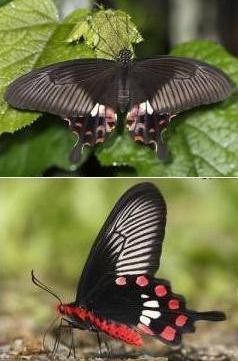If you line up males and females of the Common Mormon butterfly, you would think they are from different species. The females are confusing — some resemble males and some mimic poisonous butterflies to fool predators. New research has found that a single gene codes for all of this wondrous complexity1.

The Common Mormon butterfly (top) closely mimics the toxic Common Rose (bottom) thanks to the doublesex gene. Credit: K. Kunte
The females of the Common Mormon ( Papilio polytes ) appear in four forms — one that looks like the male of the species, and three 'disguises' which mimic the toxic Rose butterflies ( Pachliopta sp.) — from the colour and wing pattern to the tail like projections on the hind wing. For a long time, scientists have thought that female mimicry is coded for by a 'supergene' — a set of genes that control different aspects of mimicry, inherited together in a single block between generations.
Krushnamegh Kunte from the National Centre for Biological Sciences in Bangalore worked with a team from the Universities of Chicago, Boston and Cornell, to find out more about the genetic basis of mimicry in the Common Mormon. The results point not to a supergene, but to a single gene — doublesex.
Mimicry is not the only thing doublesex controls. It is also involved in sexual differentiation, and codes for male and female genitalia. Evolution of mimicry has given it an additional function. "The doublesex gene is highly conserved and well-characterized in insects. Its function in sexual differentiation is understood a fair bit, but previously it had not been implicated in wing patterning," Kunte says.
Mapping the butterfly genome
The researchers generated butterfly populations of different female forms of P. polytes and conducted breeding experiments using the purebred populations. Using analytic tools, they could map the region responsible for mimicry to a fragment of 300 kilobases, which included about five genes. One of these genes was doublesex.
Moving on from this 'intriguing' finding, the researchers compared the genomes of 15 mimetic and 15 non-mimetic females, using the technique of association mapping. The comparison showed that the doublesex gene was highly associated with the mimicry phenotype, while the surrounding regions were only weakly associated.
The doublesex region was also special because of the way it was evolving. Generally, genome regions harbouring a lot of mutations get selected in the course of evolution. Doublesex was no different. There were mutations unique to the mimetic female form. At the same time, some regions of doublesex were the same in the mimetic and non-mimetic forms. These were probably responsible for sexual dimorphism.
"The co-option of this well-known sexual differentiation gene in controlling polymorphic mimicry is indeed an unexpected and exciting discovery," Kunte told Nature India .
Chris Jiggins, Reader of Evolution at Cambridge University, says it isn't surprising that the gene with such a conserved function could also be co-opted to pattern specification. "Historically, scientists like Fisher have speculated that mimicry supergenes are similar to sex determination, but I think none of them would have expected that the same gene would be involved in both."
Multitasking at the genetic level
The same genetic code can result in different mRNAs, which are molecular messengers that take instructions from the genome to different parts of the cell. P. polytes females can make three distinct mRNAs from doublesex . Two of these forms are found in higher amounts in mimetic females.
P. polytesis not the only butterfly with multitasking genes. Jiggins gives the example of its sister species, the African swallowtail Papilio dardanus , where the genes engrailed and invected are involved in mimicry. "In this case as well, a single gene with a conserved function has been co-opted for mimicry," Jiggins said.
Heliconius numata also has a supergene that allows it to morph into seven different forms, mimicking different species from the genus Melinaea . But P. polytes is special because "it's a single gene, not a supergene, and it has been co-opted from another function", Kunte says.
So why the multitasking? "Probably because mimicry evolved at a later stage," Kunte says. "It evolved under very specific circumstances of a particular kind of ecological pressure, where species evolved polymorphism to evade predators."
More research could answer further questions such as the genetic basis of mimicry in other species and the mechanisms leading to such diverse forms. The researchers feel that advances in technology such as sequencing large amounts of DNA and specific analytic tools could lead to more exciting research.
